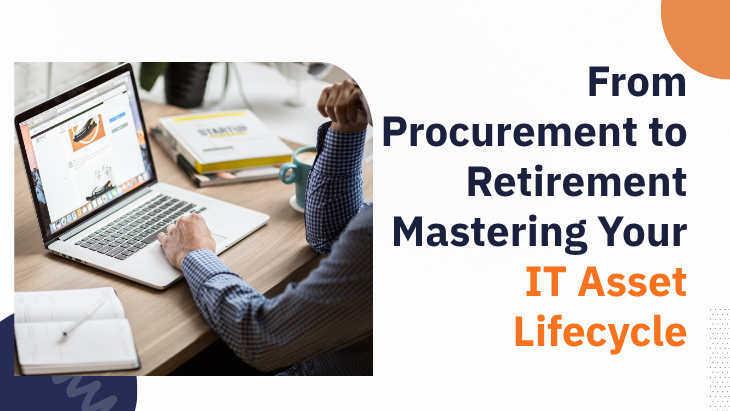In the rapidly evolving digital economy, IT asset management is not merely a technical activity it's a strategic imperative. Each device, server, or software license utilized by a business progresses through a full cycle from acquisition to ultimate disposal. Integrated IT & Hardware Solutions The entire process is referred to as the IT asset lifecycle. Well-managed, it lowers cost, improves performance, enhances compliance, and aids organizational growth. One of the best methods for streamlining this lifecycle is via integrated IT & hardware solutions, which consolidate asset tracking, maintenance, procurement, and end-of-life operations within a single system.
Starting with Smart Procurement
The lifecycle starts with procurement, where carefully made purchasing decisions can have a long-term impact. Organizations have to weigh performance, price, and vendor reliability when choosing IT hardware or software. But procurement is more than just cost-cutting. It encompasses coordinating asset purchases to business objectives, future-proofing vendor choices in terms of scalability, and reducing vendor fragmentation. Integrated IT & Hardware Solutions streamline this by providing a single platform to analyze vendor performance, facilitate purchase approvals, and predict future requirements, making procurement not only reactive but proactive.
Deployment: Beyond Installation
After an IT asset is purchased, the deployment process begins. This process involves inventory logging, initial setup, security configuration, and training of users. Disorganized deployment can result in shadow IT, security loopholes, and wastage of resources. With integrated IT & hardware solutions, deployment becomes a well-structured process whereby all assets are labeled, tracked, and securely configured prior to being assigned to an end user. IT staff can automatically provision roles, track initial usage, and enforce compliance with business policy both efficiently and securely.
Usage and Performance Monitoring
Once deployed, IT assets are in their longest phase—active use. This is where performance, uptime, and maintenance are most important. Tracking asset health, maintaining software compliance, and reacting to faults are imperative functions that dictate how much value the organization gets from its investment. Integrated IT & Hardware Solutions offer real-time performance dashboards, alerting, and maintenance scheduling that reduce downtime. With remote diagnostics and automated patching, organizations are able to extend the life of assets by many years while ensuring optimum performance and cybersecurity hygiene.
Mid-Life Upgrades and Asset Optimization
Halfway through an asset's life, performance could begin to decline or needs can shift. Here, upgrades, extensions, or redeployments tend to be called for. Rather than rendering and replacing these assets, firms can reconfigure or reallocate usage. IT & Hardware Solutions, integrated, identify those assets that are not performing well or being underused and suggest the best course of action, perhaps a memory upgrade, software update, or asset reassignment to a different department. Such smart lifecycle management thus fosters sustainability and cost efficiency.
Compliance and Documentation Throughout the Lifecycle
Regulatory compliance and documentation are important throughout the lifecycle. From licensing software to data protection, companies need to monitor every modification, upgrade, and entry point connected with their IT assets. For industries that have some kind of regulation, such as finance or healthcare, stakes are higher. Integrated IT & Hardware Solutions provide built-in audit trails, versioning, and compliance reporting to ensure that companies remain in accordance with industry standards. Having centralized documentation not only benefits audits but also minimizes the chances of penalties and legal issues.
Retirement and Disposal Planning
No IT asset is eternal. When computers or software are at the end of their useful life, companies have to retire them properly. Retirement is not an issue of simply unplugging and replacing retirement involves erasing sensitive information, being environmentally compliant, and extracting remaining value if it can be done. With integrated IT & hardware solutions, retirement of assets is a process with a framework. The platform confirms that data is safely erased, decommissioning is recorded accurately, and e-waste legislation is complied with. It also allows companies to analyze asset depreciation and make procurement planning decisions in the future based on retirement patterns.
The Importance of Lifecycle Reporting and Analytics
After an asset is retired, companies can utilize data across the lifecycle to enhance procurement, use, and disposal in the future. Lifecycle reporting is beneficial for budgeting, forecasting, and strategic planning purposes. Integrated IT & Hardware Solutions offer in-depth analysis of asset usage, downtime, repair history, and total cost of ownership. These observations enable CIOs and IT managers to spot gaps, steer clear of repeat trouble spots, and build a better overall digital backbone for the organization. In short, yesterday's data makes tomorrow's decisions more intelligent.
Aligning IT Lifecycle with Business Objectives
At the core of each IT asset is a business function that it enables—communication, analysis, security, or customer service. This is the reason why the IT asset lifecycle should be aligned with wider organizational objectives. Integrated IT & Hardware Solutions close this gap by providing transparency throughout departments. Financial teams can view depreciation patterns, HR can match equipment to new employees, and compliance officers can perform automated audits all from one system. When the asset life cycle is brought into full business planning integration, it's a productivity driver, not a technical necessity.
Conclusion
From procurement to retirement, every phase of the IT asset lifecycle is unique in terms of challenges and opportunities. Praise-Group Optimizing this lifecycle is no longer a choice it's a necessity. With integrated IT & hardware solutions, organizations have complete control, visibility, and intelligence on their IT infrastructure. Automating processes, maintaining compliance, and utilizing real-time information enable businesses to achieve maximum ROI, drive user productivity, and facilitate long-term digital transformation. In the era of fast-paced technology development, owning your IT asset lifecycle isn't merely smart management it's a competitive edge.





Leave a reply